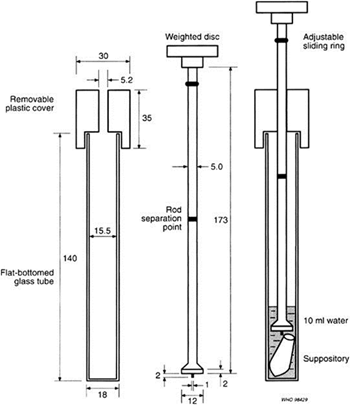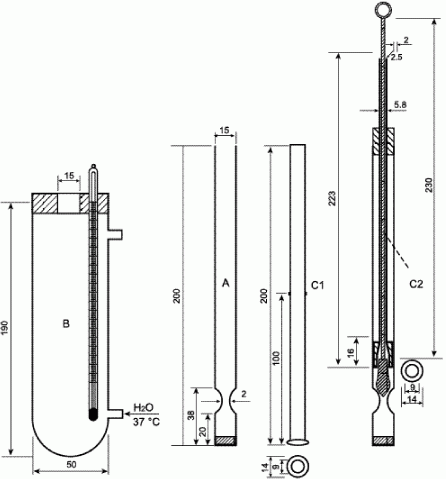Supplementary information: Test methods used during development or manufacture: Softening time determination of lipophilic suppositories
2015-01
This text is reproduced from the European Pharmacopoeia with permission and with appropriate editorial modifications.
This test is intended to determine, under defined conditions, the time elapsed until a suppository maintained in water softens to the extent that it no longer offers resistance when a defined weight is applied.
Method A
Apparatus
The apparatus (see Figure 1) consists of a glass tube 15.5 mm in internal diameter with a flat bottom and a length of about 140 mm. The tube is closed by a removable plastic cover having an opening 5.2 mm in diameter. The apparatus comprises a rod 5.0 mm in diameter that becomes wider towards the lower end, reaching a diameter of 12 mm. A metal needle 2 mm in length and 1 mm in diameter is fixed on the flat underside.
The rod consists of 2 parts, a lower part made of plastic material and an upper part made of plastic material or metal with a weight disc. The upper and lower parts are either fitted together (manual version) or separate (automated version). The weight of the entire rod is 30 ± 0.4 g. The upper part of the rod carries a sliding mark ring. When the rod is introduced into the glass tube so that it touches the bottom the mark ring is adjusted to coincide with the upper level of the plastic cover.
Procedure
Place the glass tube containing 10 mL of water in a water-bath and equilibrate at 36.5 ± 0.5 °C. Fix the glass tube vertically and immerse to a depth of at least 7 cm below the surface but without touching the bottom of the water-bath. Introduce a suppository, tip first, into the tube followed by the rod with the free gliding plastic cover into the glass tube until the metal needle touches the flat end of the suppository. Put the cover on the tube (beginning of time measurement). Note the time elapsed until the rod sinks down to the bottom of the glass tube and the mark ring reaches the upper level of the plastic cover.

Figure 1. Method A - Apparatus for measuring the softening time of lipophilic suppositories. Dimensions in millimetres
METHOD B
Apparatus
The apparatus (see Figure 2) consists of a water-bath (B) into which an inner tube (A) is inserted and fixed with a stopper. The inner tube is closed by a stopper at the bottom. The apparatus is fitted with a thermometer. Two insets are available:
- a glass rod (C1) in the form of a tube sealed at both ends, carrying a rim at its lower end weighted with lead shot, which has a weight of 30 ± 0.4 g;
- a penetration inset (C2) consisting of a rod (7.5 ± 0.1 g) in a tube which has an enlargement for the suppository, both made of stainless steel.
Procedure
Pour 5 mL of water at 36.5 ± 0.5 °C into the inner tube (A), introduce a suppository with the tip downwards and onto that place the inset (C1 or C2). Note the time elapsed between this moment and the moment when the lower, rimmed end of the glass rod (C1) or the steel rod (C2) reaches the narrowed part of the inner glass tube. Melting or dissolution is then considered as complete.

Figure 2. Method B - Apparatus for measuring the softening time of lipophilic suppositories. Dimensions in millimetres